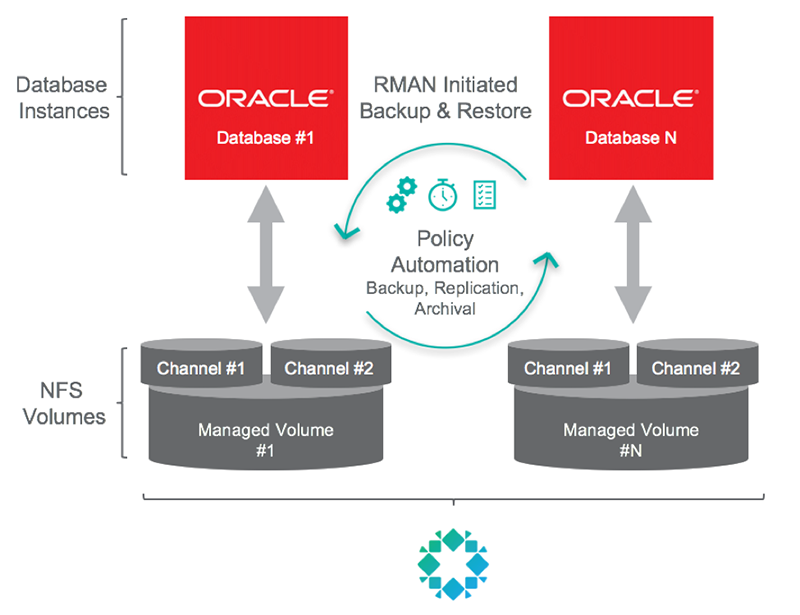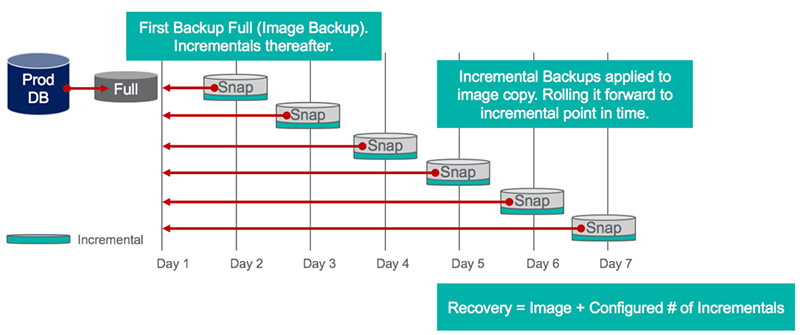Oracle databases are a critical part of many IT environments. With the Rubrik Alta release, we are excited to announce support for Oracle. Our goal is to provide core Rubrik benefits such as immutability and a single policy engine for retention + archival + replication, while tightly integrating with native Oracle capabilities.
Our approach is to integrate with RMAN to offer agentless support and allow Oracle DBAs to continue using familiar tools. The integration provides support for ASM – a notable difference from array-based snapshot methods. Rubrik supports all database topologies (RAC, Exadata, etc.) and recovery types.
While an easy and technically feasible approach would have been providing an NFS export and stopping there, Rubrik is intentionally not a “dumb target” for database backups. Our engineers rejected that approach as not staying true to the core Rubrik platform benefits. However, we are using NFS as a transport mechanism for ingesting RMAN backups into Oracle. From there, Oracle backups are preserved in an immutable format and managed via the same Rubrik policy that applies to all other datasets.
Under the Hood
The core new feature that supports Oracle backups is the concept of a Managed Volume – an NFS mount point exposed to Oracle servers in a read-only format.
At the beginning of an RMAN backup, the begin_snapshot API call to Rubrik makes the Managed Volume available as read/write for RMAN to use as a backup destination. Once the RMAN backups are complete, an end_snapshot API call will move the Managed Volume back to read-only. From that point, an Atlas File System snapshot preserves the data immutably, and the snapshot is catalogued.

Immutability is a critical property in today’s threat landscape. Our integration delivers the same immutability capabilities that Rubrik provides other datasets. See the Data Integrity Technical White Paper for more details on immutability.
For simplicity and scalability, there is Floating IP-based failover capability that keeps the NFS mount available at the same IP address, even if there is a node failure or reboot. Multiple channels are also supported, which naturally fits with Rubrik’s scale-out architecture.
Once the backup is complete, the same Rubrik SLA policies used for other datasets apply. If using an existing policy, no additional configuration is required. This allows DBAs to control RMAN scheduling, and the SLA policy handles retention, replication, and cloud archival, leveraging “tried and true” Rubrik functionality.
Full vs. Incremental Backups
If desired, DBAs can send full backups to Rubrik. However, Oracle does support block change tracking for incremental backups.
To provide the same incremental-forever benefit to other Rubrik datasets, we support and recommend the use of an advanced RMAN capability called Incremental Merge. With this feature, users can take an initial full backup and subsequent incremental backups. Then, on a rolling basis, they can update the full backup with a previously taken incremental.
The process rolls the image backup forward to the point in time when the level 1 incremental was created. During restore and recovery of the database, RMAN can restore from this incrementally updated copy and apply changes from the redo log. This delivers the same results as restoring the database from a full backup taken at the time of the most recently applied incremental level 1 backup. This strategy minimizes time required for database recovery.

APIs? Oh Yes.
All Oracle backup operations from a Rubrik perspective are exposed via API, which works well with the scripting required by RMAN. In the future, Rubrik will be providing a best practice guide along with script templates.
We’re very happy with how our Product Management and Engineering teams have been able to offer an integrated Oracle backup approach while staying true to the core Rubrik benefits.
Want to learn more? Watch our on-demand webinar on the Rubrik and Oracle integration.
